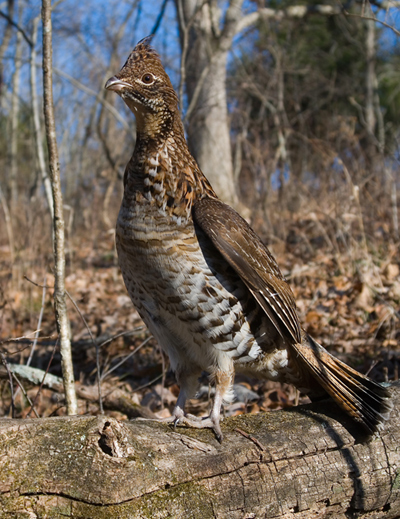By Art Lander Jr
FRANKFORT, Ky. – The importance of habitat to wildlife is fundamental.
Habitat provides all the ingredients necessary for wildlife to live and thrive: food, water and the cover to escape predators while raising a family.
The health and vigor of wildlife populations is often directly correlated to the quality of the habitat.
“In good habitat, does breed at 1 1/2 years of age and have twins every year as an adult,” said Tina Brunjes, deer program coordinator for the Kentucky Department of Fish and Wildlife Resources. “In poor habitat, does have smaller fawns and may have twins, but usually both don’t survive.”
What makes good wildlife habitat?

“If there’s land in all stages of plant succession – mature forest, young forest, brush, and open land – in close proximity, there’s good wildlife potential,” said Ben Robinson, small game biologist for Kentucky Fish and Wildlife. “Cover is often the limiting factor. If you stop mowing and let an area grow up, the natural seed bank will provide plenty of food for wildlife.”
The amount and variety of food available has a direct impact on the number of animals that can be supported by the habitat.
Along the Ohio River, and in southeastern Kentucky, where counties are heavily forested, deer are dependent on mast, such as acorns, as their main food source. “Hunters see more deer with fawns following a good mast crop and it’s reflected in the harvest,” said Brunjes.
Some wildlife species have very specific habitat needs. A good example is the bald eagle, which now nests all across Kentucky.
“Eagles typically nest close to water, where there’s a good supply of fish,” said Kentucky Fish and Wildlife Avian Biologist Kate Heyden, in a 2010 interview for Kentucky Afield magazine. “They make their nests in tall, old trees or snags.”
Because of the number of large reservoirs built statewide since the 1940s, eagle habitat is more widespread in Kentucky than during the 18th century pre-settlement era. This results in a wider distribution of eagles in Kentucky.
The ruffed grouse and bobwhite quail are two upland game bird species whose populations in Kentucky have declined in recent decades due to a loss of habitat.
The success of grouse is tied to early successional stages of growth in forests. As woodlands mature, it is harder for grouse to find the conditions they need.
“Grouse prefer young forests, with a high stem density that provide food (seeds and berries) and nesting cover (underbrush),” said Robinson. “Our forests lack that component.”
The bobwhite quail is an iconic gamebird that requires grassland habitat. This is now absent from most of the state, a victim of changes in land use, farming practices and other factors.
“Bobwhite recovery has always presented a unique challenge to biologists changing the attitudes of people in order to effect the changes to the landscape that are necessary for the game bird’s recovery,” said Kentucky Fish and Wildlife Commissioner Dr. Jon Gassett, a lifelong quail hunter. “Until we restore that habitat, the foothold of the quail will be tenuous at best ”
Other species are habitat “generalists,” able to thrive in a variety of vegetative conditions.
“The white-tailed deer is the poster child of habitat generalists,” said Brunjes. “Deer can adapt to cities and suburbs, a mix of open land and woodlands, even swamps and sloughs. The only two places deer can’t live year-round in Kentucky are a parking lot and in the middle of a lake. They are survivors and that’s one of the challenges as a deer manager.”
During deer restoration, which ended in 1999, the strategy was to find a source of animals, live trap and relocate them. The amount of deer habitat available was never a question.
For landowners there are many benefits to be derived from an active habitat management program. The conservation of soil and water; the creation of quality forage that boosts soil fertility and provides food for livestock; and the improvement of stands of hardwood timber all benefit wildlife and the landowner. Timber presents a renewable resource of great economic value.
To fully reach the potential of wildlife habitat, it’s important to develop a management plan, establish work projects and decide which wildlife species will be a priority in the management plan.
Consult your local private lands wildlife biologist for advice and technical guidance on habitat improvements on your land. Visit the department’s website at fw.ky.gov. Click on Maps and Online Services, then Other KDFWR Maps, then Wildlife Private Lands Biologists.
Author Art Lander Jr. has been writing about the outdoors since the 1970s. He is a staff writer for Kentucky Afield Magazine.
Media Contact: Art Lander Jr 1-800-858-1549, ext. 4414


Be the first to comment